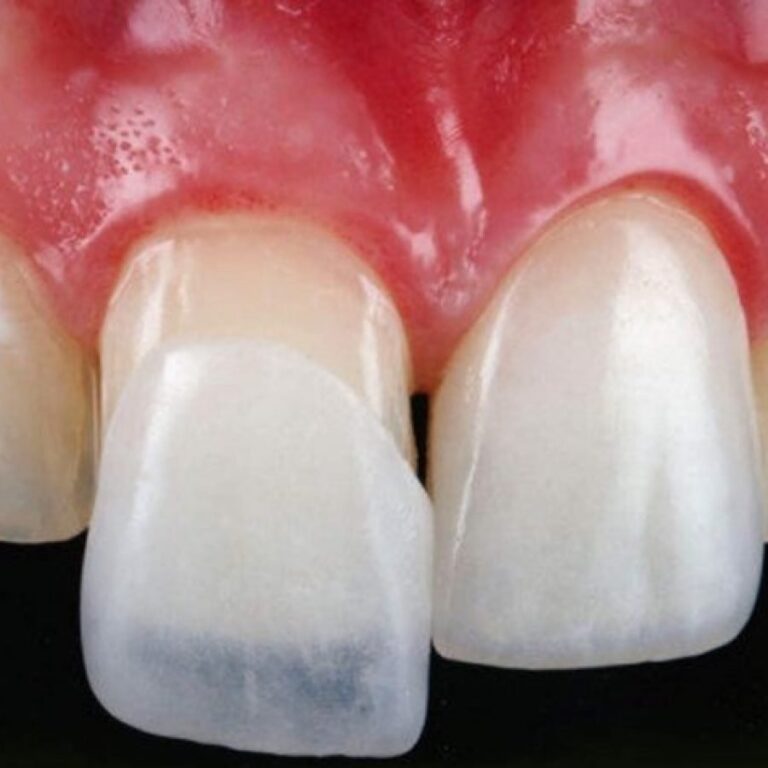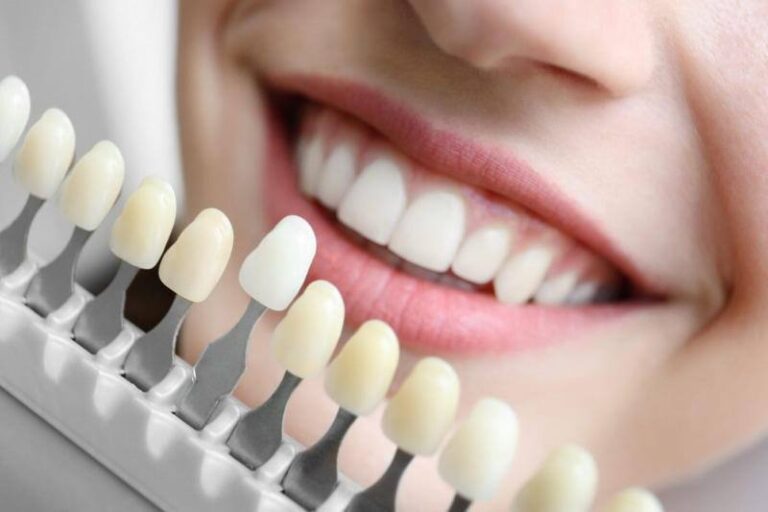Installation of veneers and lumineers

What are lumineers?
Lumineers are thin ceramic onlays (a few microns thick) that are placed on your own teeth without having to be grinded down. Lumineers are often referred to as a type of veneer, but they are considered safer, more comfortable, and lighter. Lumineers are not harmful to the patient’s own teeth, and are commonly known worldwide as “Hollywood Veneers”. A special adhesive is used to attach them, which gives a 3D effect, creating a transparent tooth.
- Teeth are not being grinded
- Lumineers are safe and can be placed without anesthesia
- No recovery period
- Look as natural as possible
If you have any questions about veneers, ask them here.
Advantages of Lumineers
- The integrity of your own teeth is retained completely
- The procedure itself is not traumatic and takes less time
- Long-lasting
- Protect natural teeth from chipping and cracking
- Allow you to solve aesthetic problems quickly
In what cases is lumineers recommended?
Enamel erosion
Chipped teeth
Gap between teeth
Changing the color of teeth
Uneven shape of teeth
Stages of lumineers installation
Stage 1
To begin with, an oral examination and professional cleaning is carried out. If there are cavities or inflammatory conditions, the teeth and gums are treated. The shade of the lumineers is chosen to be as close to the natural colour as possible.
Stage 2
The teeth are grinded. In this step, the dentist roughens the surface of the teeth to ensure better adhesion of the lumineers to the surface. The procedure does not require anaesthesia as the sensitive parts of the teeth will not be affected.
Stage 3
Dental impressions are taken and sent to the manufacturer’s laboratory. You then have to wait for the veneers to be made and for them to arrive at the clinic. This process usually takes up to 3 weeks.
Stage 4
After arrival, the lumineers are fitted with a special adhesive that contains fluoride to better protect the enamel.
What are veneers?
Their advantages include:
- Full identity in your own teeth
- Ability to choose the desired shade for your smile
- Durability and toughness
- Do not stain, do not change shape and have the shine of natural teeth

If you have any questions about veneers, ask them here.
Advantages of veneers
- Durability and toughness guarantees long wear
- Reliability and no problems with allergic reactions
When are veneers used?
Cracked enamel and chips resulting from mechanical damage to the tooth or weakened enamel.
Gaps and gaps between teeth (diastema and trema), congenital or caused by the loss of one or more teeth.
Yellow or darkened teeth that cannot be whitened or are too sensitive. Stains and erosions of enamel.
Various abnormalities in the size or shape of teeth, congenital anatomical abnormalities in the configuration of dental crowns or tooth roots.
Alteration of the physiological shape of the teeth, increased enamel sensitivity.
Mild clustering and curvature of teeth. Tilted, rotated teeth and other minor anomalies.
Stages of veneers installation
Stage 1
To begin with, the oral cavity is examined and professionally cleaned. If caries or inflammatory conditions are present, treatment is carried out. Models are fabricated so that the patient can assess what kind of result awaits him or her.
Stage 2
The teeth are grinded. In this step, the doctor roughens the surface of the teeth to ensure better adhesion of the veneers to the surface. The procedure does not require anaesthesia as the grinding will not affect the sensitive parts of the teeth.
Stage 3
Dental impressions are taken and sent to the manufacturer’s laboratory. You then have to wait for the veneers to be made and for them to arrive at the clinic. This process usually takes up to 3 weeks.
Stage 4
Once the veneers have arrived, they are fitted with a special adhesive that contains fluoride to better protect the enamel.
Book a consultation
If you can’t find the right dental service or appointment time, call our reception desk at +372 66-440-66.
How do you know what's right for you?
Teeth veneers
- Thickness 0.3 - 0.5mm
- Duration 7-10 years
- Teeth need to be grinded
- Temporary crowns will be required
- Teeth need to be restored after veneers are removed
Lumineers
- Thickness 0.2 - 0.3mm
- Duration 15-20 years
- Teeth are not grinded during installation
- Installation occurs in 2 visits
- A more natural-looking and natural-looking teeth

“Let your teeth
be beautiful
and healthy.
Smile – it suits you!”
Irina Traksler - installation of veneers and lumineers
Before / After
Reviews from patients of Dr. Irina Traxler
"Hollywood smile"
If you need aesthetics, then only to this doctor. She will advise, explain, tell and show you everything. Minimal pain and discomfort, maximum results. She is a master of her craft 100%
"Excellent level"
Very neat and quality work.
"Best dentist ever!"
Nothing to add, just the best doctor and she and the assistant!
"Very good and attentive doctor! I recommend!"
Very good experience with this doctor, very attentive and professional.
"Luminaries"
Installed luminaries, excellent all done, very polite, kind, careful, the best dentists I have met, advise everyone!
"Luminaires"
I had luminaires fitted at the Dental Visit clinic by Dr Irina Traksler. Very pleasant and experienced doctor. I am very satisfied with the result, beautiful and natural. I recommend:)
"I also recommend."
very nice dentist, recommend to all!
"If you need aesthetics, this is the best doctor"
Everything explained, told, showed, advised – the most important thing. Mega qualified doctor. 100% recommended.
"Excellent hands"
I have been afraid of dentists all my life. Not anymore. I recommend to everyone
Price list
-
Consultation al € 30
-
Panoramic image (2D) € 29
-
3D scan (upper and lower jaw) € 80
-
A written treatment and prosthetic plan € 55
-
R2GATE surgical template planning (3D scan + high precision impressions) € 190
-
Injection anaesthesia € 16
Frequently asked questions
Absolutely painless. The pre-treatment of the teeth does not involve serious interference and is performed only in the area of the tooth enamel. If the patient wishes, local anesthesia can be used to relieve possible discomfort.
Ceramic veneers and lumineers are attached using proprietary dental materials with a special technology, so peeling is excluded.
Veneers and lumineers are made in a special laboratory and we are fully responsible for their quality and reliability. The laboratory employs dental technicians with many years of experience, who regularly receive advanced training and education to work with new materials and technologies. However, the warranty is valid only if the care conditions for the veneers are followed: no chewing of nuts, opening of bottles or gnawing of hard objects with the teeth. It is strongly recommended to wear a mouth guard at night to prevent damage to the veneers by possible bruxism.
Yes, there are contraindications. Veneers and lumineers are not recommended for people with malocclusions or bruxism. If the teeth are destroyed by more than 50%, the placement of veneers and lumineers is also not recommended. In the presence of dental caries and other dental diseases must first be treated.
Modern veneering technology does not require deep edging. Our doctors prepare tooth enamel under a microscope. The enamel is grinded off within 0.3 to 0.5 millimeters.
After the placement of veneers or lumineers, the feeling in the mouth may be a little unaccustomed, but this passes very quickly. Diction rarely changes, but if it does, it usually takes a few days to adjust.
Veneers and lumineers need to be brushed twice a day, just like your teeth. Use dental floss. It is not recommended to use toothpicks, chew hard objects, consume drinks and foods with high content of food dyes. Once every six months, it is advisable to see your dentist and wear a mouth guard at night.
The cost of veneers and lumineers is influenced by many factors. The most important ones are the cost of the material and the method of fabrication. Fabrication of ceramic veneers requires a high degree of professionalism and time commitment from the dentist and dental technician.
First, an impression of the teeth is made, then the mold is made, and the technician builds the future veneers by hand, layer by layer. The process of veneer fabrication is completed by firing the veneer in the oven. Thus, the creation of the finest veneer, visually indistinguishable from the tooth, can only be compared with the birth of a piece of jewelry: the work must be so professional and accurate. Of course, such work simply cannot be inexpensive!
Book a time
If you can’t find the right dental service or appointment time, call our reception desk at +372 66-440-66.